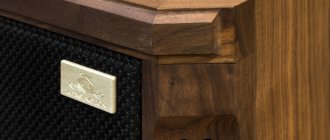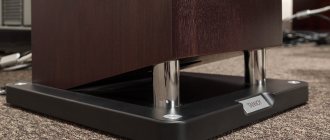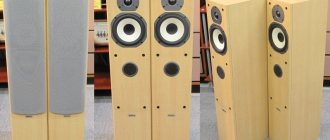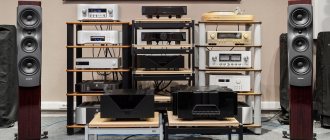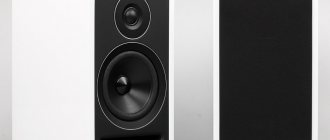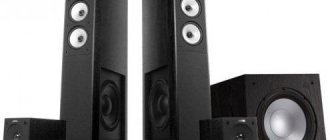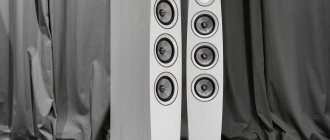When selecting a system, the combination of acoustics and amplifier makes the maximum contribution to its sound. Finding this combination is usually done by trial and error. Therefore, it is better to record all successful or at least interesting options found. This time the case study consists of Naim components and Tannoy speakers.
Save and read later -
Let's start with the Naim amplifier. For its 70 W per channel, Nait XS 2 turned out to be quite compact thanks to the toroidal transformer and the operation of the output stages in class AB. However, they did not skimp on the headphone amplifier - it is made in pure class A. Among other important details that add up to the Naim sound, it is worth mentioning ceramic spacers under the output transistors, custom film capacitors and optimized internal wiring to shorten the signal path and reducing interference.
The semi-matte black Tannoy front panel paint matches the powder finish of the Naim components.
Connectivity includes an array of DIN and RCA inputs, subwoofer and power amplifier outputs. There is an AV-bypass mode that allows you to integrate the amplifier into a home theater system. You can improve the sound quality of the device using a proprietary external power supply, for example, FlatCap XS.
XS 2 - the middle model in the Nait series of integrated amplifiers
The control application for the Naim ND5 XS network player, which is constantly being improved and has even changed its name. The most pleasant feature, in my opinion, is the ability to “flip through” the booklet, which consists of additional information about the currently playing album, which is downloaded from the Internet immediately after playback starts.
There are a surprising number of features available from the front of the Naim ND5 XS
If you don’t have a smartphone or tablet, and your eyesight is good, almost all functions can be controlled using the included remote control, looking at the player’s small built-in monochrome display. Moreover, several buttons on the front panel will allow you to do without a remote control at all for most basic operations and some settings. Today, not all streamers offer this option. But sometimes it is really necessary. For example, in my case, when the Wi-Fi access point was unstable, at first it was not clear why the application was malfunctioning. Connected via Ethernet and controlled from the front panel, the ND5 XS remained completely unperturbed at this time. Thus, the problem was identified and resolved by rebooting the router.
The app allows you to create playlists, manage multiple Naim devices and manage your favorite internet radio station list
In addition to the standard Naim way of improving sound by purchasing an external power supply, there is also a free one - updating the firmware. It mainly expands the capabilities, but during the model’s existence so many of them appeared that in a sense, it turned the ND5 XS into a new device. Sampling rates for FLAC, WAV and AIFF have increased, and DSD support has been added. All this is true for streaming over a local network and for playing files from USB. This port only supports flash drives - not suitable for HDDs. One of the most recent innovations is working with the Tidal streaming service.
Standards competition
The presence of DIN and RCA connectors on both Naim devices allowed us to experiment a lot with the connection. These outputs in the player are activated through the menu, which is not very quick; in addition, the manufacturer does not recommend keeping both of them turned on for reasons of sound quality, so at the beginning of the test we had to select one option and stop there.
A flap on the back of the ND5 XS hides a socket to which you can connect external power supplies: XP5 XS, XPS or 555 PS
The proprietary DIN connection provided better scene definition and overall greater detail, but the RCA connection made you want to continue listening instead of analyzing. You could say that through RCA the sound was musical and exciting, while through DIN it was more accurate and in some ways predictable.
The Nait XS 2's set of inputs and outputs will allow it to fit into any modern and fairly extensive system, not necessarily consisting of Naim components alone
Partly, some difference in the class of cables played a role here - I was offered Atlas Element (DIN) and Audio Note AN-S (RCA) - the second of those mentioned costs almost twice as much as the first. For formal reasons, I preferred the DIN connection, as it provides a little more information.
Response speed and MM phono stage
However, let's focus on the test object - the Nait amplifier from the second oldest XS series. There are no external changes compared to its predecessor, but Naim specialists have seriously worked on the electronic circuits of the device. In particular, they managed to double the speed of the voltage amplification cascade, and, as a result, the speed of the final response. The transistors of the second amplifier stage have been optimized and no longer require cascode shielding, which also leads to increased response speed. And this was sure to have a positive effect on the sound.
Amplifiers in this price range are often equipped with switchable MM/MC phono stages, but Naim believes that it is better to achieve maximum quality with support for MM cartridges, rather than complicate the design with circuits that require even more reliable protection from interference and noise and provide operation with much weaker signals from MC heads.
The MM phono stage that Nait XS 3 has is made of three stages: an amplifier, a passive equalization stage and a final amplifier with active equalization. This solution provides an excellent signal-to-noise ratio, the possibility of RIAA equalization outside the audible range and overload margin.
The capacitors and resistors used in the block are film elements for output mounting with a reduced microphone effect and excellent peak characteristics. Since the inputs to the phono stages are three orders of magnitude more sensitive than others, this solution can significantly improve sound quality.
The power supply with a huge toroidal transformer guarantees reliable energy support for the sound.
At its core, Naim Nait XS 3 repeats time-tested proprietary solutions: class AB power amplification, the use of an Alps Blue Velvet volume control, a reed relay for input selection, ceramic insulators for power transistors, as well as the use of galvanic isolation of the microprocessor control section and protection of printed circuit boards from the microphone effect.
Sound
This property was well demonstrated by the kit using the Rush “Power Windows” disc as an example. A series of sounds and timbres, guitars and synthesizers passing the baton to each other, line up in unbreakable chains. As a result, this rich arrangement does not break down into its component parts, but rather envelops the listener, forcing him to immerse himself in this flow of information and rhythms. The bass is powerful, but neat, and the tempo changes are rapid. The Dutch trio Noisia helped me appreciate the kit's outstanding speed capabilities. Bass, wideband and many other sounds with sharp attack and minimal spatial processing came and went almost instantly, and in all areas of the spectrum.
Lightweight Tannoy paper diffuser means good speed and above average sensitivity
The resolution of the entire system is such that compression artifacts were noticeable on all Internet radio stations with streams up to 320 kbps. So despite the excellent selections of Naim's Choice, I would reserve this feature for background listening. Fortunately, the Tidal player's support opens up fairly broad horizons for the music lover in search. Roger Daltrey's new album highlighted the set's outstanding rhythmicity. The precise processing of vocals and careful attention to dynamics encouraged us to turn the volume knob to the right.
HF level and roll-off switches are useful in an overly muted or completely ringing room.
The Naim Nait XS 2 amplifier will not use the Cheviot's bi-cable capability.
If you didn’t know that the Naim amplifier is capable of handling many “heavy” speakers, it might seem that the Tannoy Cheviot is a light load, so lively and agile is this combination. The system can remain neutral if presented with modern recordings of symphonic music, but will happily highlight the analog origins of old classic rock albums.
The network player (second from the top) has to grind a lot of data, so it gets even hotter during operation than the amplifier (third from the top)
The loudspeaker market has been dominated for many years by the trend of smaller speakers as their number increases. Exceptions, as a rule, are served with retro sauce and appeal to the roots. The Legacy series, which includes the Cheviot model, was also released in the footsteps of the famous Tannoy speakers of the 70s of the last century and repeats their form factor. Large speaker means high sensitivity and good speed. But it also determines the width of the front panel, and it sets a narrow focus. And even a coaxial design, which brings the speaker characteristics as close as possible to a point sound source, is unable to resist this.
Naim Nait XS-2
Analog inputs: 5 DIN, 5 RCA, power amp IN || Analogue outputs: DIN, RCA Subwoofer, Phone || Output power: 70 + 70 W (8 ohms), 100 + 100 W (4 ohms) || Input sensitivity: 130 mV || Power consumption in silent mode: 16 W || Dimensions: 432 x 70 x 301 mm || Weight: 8.4 kg || Price: 120,000 rub.
- MUSIC WE LISTENED TO
- 1. Carl Orff, “Carmina Burana”. Andre Previn and London Symphony Orchestra. EMI Classic, 1999
- 2. "Naim Sampler #8". Naim Label, 2013
- 3. Showcase, “Acoustic music in authentic environment.” SACD Opus 3 Records, 2000
- 4. Dream Theater, “Falling Into Infinity.” EastWest Records, 1997
- COMPONENTS
- Speaker systems Monitor Audio Gold Reference 20
- Cables:
- — interblock Cardas Cross 0.75 m
- — acoustic Kimber Cable 12TC 2 m
- — network Silent Wire AC16 1.5 m, Physics Style PW-Reference
In a group or alone?
The Cheviot's pronounced directivity means that the full spatial picture can only be heard at one point. The stage is not too deep, but stable, and in azimuth it provides literally centimeter accuracy. Whatever disc you put on, all the musicians immediately take their places in front of the viewer. On the other hand, when you leave the optimal listening zone, the overall character of the sound changes very smoothly. Thus, all people in the room find themselves in a completely comfortable zone - both in terms of frequency response and in the sense of transparency and unobtrusiveness of the feed. I will attribute the last couple of listed properties to the merits of Nait XS 2.
This Naim - Tannoy pairing evokes a feeling of balance and completeness. And only the desire to slightly expand the area in which the stereo scene is perceived prompted me to further search for minor improvements. So, after a certain amount of experimentation, bass reflex plugs appeared - one on the outside. But this rather has to do with the size of the room and the location of the speakers in it. But only the lower grilles remain - without them, the Cheviot’s appearance, of course, has a more harmonious appearance, but their presence subtly adds depth to the scene. I dare to suggest that the metal panels of the crossover switches still introduce some unnecessary reflections.
Solid Bass Foundation
When testing the Nait XS 3, its partners in the system were the Naim NDX 2 network player from the superior Classic series and the Neat Motive SX-1 small-sized floorstanding speakers.
The first thing I would like to note is the deep and full low-frequency range. In most of the compositions we listened to, it was a significant basis, the basis of the sound. Thanks to him, the scale and realism of the musical stage was ensured when performing works for a symphony orchestra - for example, “Rhapsody in Blue” by J. Gershwin.
All instruments and their groups had enough room to breathe freely, the solos of various wind instruments were presented expressively, melodiously, their voices were rich in the timbres characteristic of each. The piano occupied a worthy place in the foreground and pleased with the fullness of the lowest notes - however, like everyone else, since the amplifier, while producing deep bass, does not deprive other frequency ranges of attention.
This stormy music sounded energetic, emotional, the rhythmic accents were placed very precisely, which only added to the excitement, infectiousness and cheerful mood.
In the solo double bass part, his string textures stood out clearly, while the notes went deep down. The percussion at the finale of the rhapsody clearly and variedly complemented his roll call duet with the piano into a full-fledged jazz trio. The final powerful crescendo was striking in its dynamic scope - while at the highest volumes the clear structure of the stage, the separation of instruments and the clarity of their voices were preserved.
Some RCA inputs are duplicated on DIN connectors. When connecting Naim NDX 2 through the latter, the sound turned out to be a little more detailed, and the stage was a little “airier”, which indicates a better signal-to-noise ratio
Keeping in mind the bass depth of the Nait XS 3, you should be careful when selecting acoustics to work with it. For example, Neat Motive SX-1 floor-standing speakers, despite their modest dimensions, are distinguished by disproportionate bass, which is created with the assistance of a bass reflex port with a port facing the bottom panel. Such tricks are successful due to the competent use of the resonant properties of this load, but the sound can get out of control. This happened when playing the album “Ten Lives” by Gwyneth Herbert. A number of songs in it are accompanied by a deep rhythmic bass line, which the speakers simply could not cope with.
But with many recordings that captured natural rather than electronically-enhanced bass, these British artists were demonstrating that they were achieving what others were abandoning. Thus, in the orchestral introduction to the aria “L'altra note in fondo al mare” from the opera “Mephistopheles” by A. Boito from the album “Verismo” by A. Netrebko, at a very low volume, the theme clearly appears in the performance of double basses and cellos with all the dynamic and tonal details and nuances. The vocals that then enter are saturated with beautiful chest tones, and the coloraturas soaring up the frequency and dynamic scale delight with their sonority and purity.
Not so sophisticated, but very soulful songs by Ella Fitzgerald from the album “Clap Hands, Here Comes Charlie” are presented simply wonderful. Her voice, articulated, expressive, rich in timbre, sounds warm and smooth, which only adds to the attractiveness and charm of her singing. The image of the artist is focused on a spacious, airy stage; she is surrounded by several instruments, also depicted in small details.
conclusions
Naim's attention to detail and authoritative nature fits well with Tannoy's cheerfulness. The system has its own character, but it is not expressed so clearly as to influence genre preferences. It must be admitted that rock music, especially recorded in the last century, benefits from it in some ways. But in other styles the kit remains neutral, and in comparison with other systems it can be called universal.
With Tannoy grills they look quite strict. And they sound best with the tops off and the bottoms on.
These speakers create a cozy feeling. It’s just pleasant to sit in front of them, as if in front of a fireplace. If so, why not include something?

